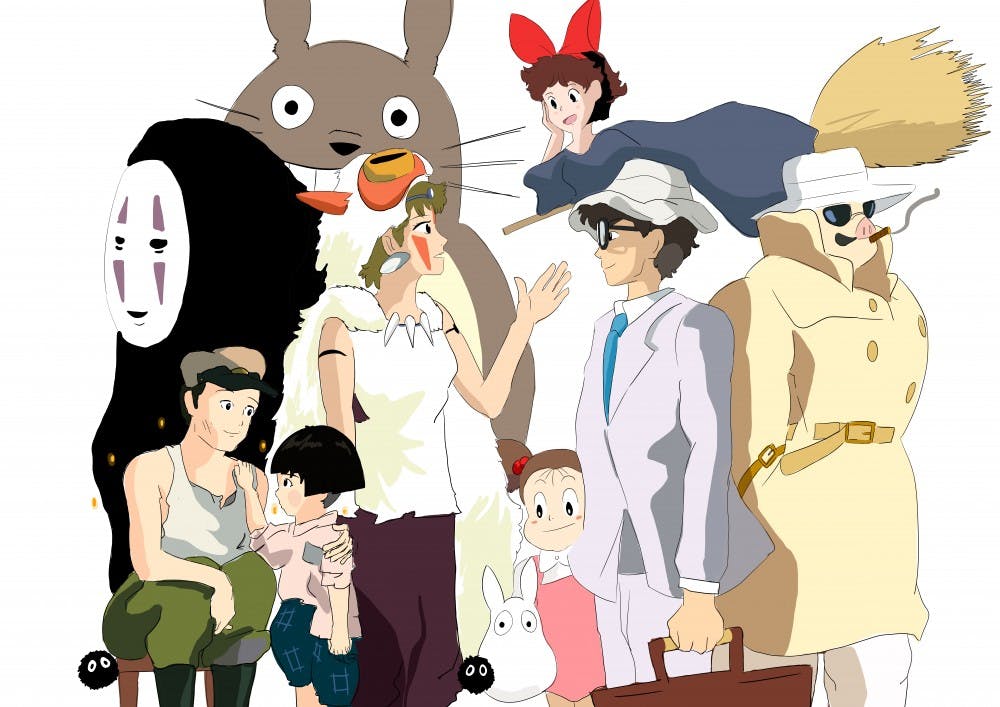On the night of January 18, 2019, I took SEPTA up to the Philadelphia Mausoleum of Contemporary Art (PhilaMOCA) and watched a heartfelt documentary about an old man and his undying need to create. Never–Ending Man: Hayao Miyazaki follows the co–founder of Studio Ghibli as he struggles with the idleness of post–retirement life and, later, his decision to pick up a new project, Boro the Caterpillar.
Objectively, Never–Ending Man is not a great documentary. Many of its shots are grainy and shaky, and the transitions used to separate the chapters of Miyazaki’s retirement—light text overlaid on a gray background—are a bit ugly. The documentary isn’t always clear, and it ends abruptly, with Miyazaki working at his desk without finding a definitive conclusion to Boro or the feature–length film Miyazaki teases in sight. If Never–Ending Man was about any other filmmaker, I would have left PhilaMOCA that Friday night unsatisfied and unhappy. But because it’s about Miyazaki, I’d pay another $12 to see it again.
Studio Ghibli entered my life as a (probably bootlegged) box set of six DVDs circa kindergarten. Throughout elementary school, I watched the classics: My Neighbor Totoro, Kiki’s Delivery Service, Laputa: Castle in the Sky, Grave of the Fireflies, and Only Yesterday. I know the set came with Nausicaä of the Valley of the Wind too, but I lost that DVD somewhere in the fervor of childhood (and I still haven’t seen it).
I watched Princess Mononoke and Ponyo in China one middle school summer by borrowing our vacation rental’s DVDs, and The Secret World of Arrietty on Dad’s laptop during the plane ride home. I watched Whisper of the Heart, Howl’s Moving Castle, The Wind Rises, and From Up on Poppy Hill throughout middle and high school. Studio Ghibli was my Disney, and I love Miyazaki with everything my heart can hold. Nope, this is in no way an objective review of Never–Ending Man—it’s a love letter to Miyazaki and PhilaMOCA, the pseudo—theater, “multipurpose–art–space,” that gifted me with a sweet, unexpected viewing experience.
On the way to PhilaMOCA from the 40th Street Trolley Portal, I missed a train, watched Google Maps flail about without GPS signal, and asked two different sets of strangers for directions. Housed in a short building labeled “FINNEY & SON” on one side and painted with Henry from Eraserhead on another, PhilaMOCA consists of one big room with a balcony. For Never–Ending Man, the venue was filled up with rows of chairs, and, by the time I arrived, adoring fans of Miyazaki.
Behind me sat an older couple with a Totoro lunchbox and in front of me sat two dude–bros who shushed each other when the documentary started. When Miyazaki effectively roasted his CGI team working on Boro, the audience I was with laughed, almost collectively, and when the music in the documentary turned jazzy, the guys in front of me whooped. The screening was loud, intimate, and fun; even though I had gone alone, I felt welcomed amongst these strangers who hung onto every one of Miyazaki’s words and works just like I did.
Never–Ending Man is poorly shot—but the life it documents passionately yearns to create and uplift others through animation, giving the documentary an air of unrefined tenderness. The people at the screening exemplified the documentary’s message of maintaining a youthful zeal for life regardless of age, because doing so might touch hundreds of hearts even half a world away. There’s a reason why I keep putting off seeing Nausicaä—there are only so many Ghibli films I haven’t seen, which means that there are only so many more times I can newly experience Miyazaki’s magic.
Cinemark University City is a five–minute walking distance from my dorm. It’s convenient and offers oftentimes great (sometimes awful) entertainment. But I’ll never be embraced with the same atmosphere of shared love for a film (or filmmaker) at Cinemark, like I was at PhilaMOCA. It’s at the less sought–out, unmarked venues where you might find a closer sense of community, if even just for a few hours.







